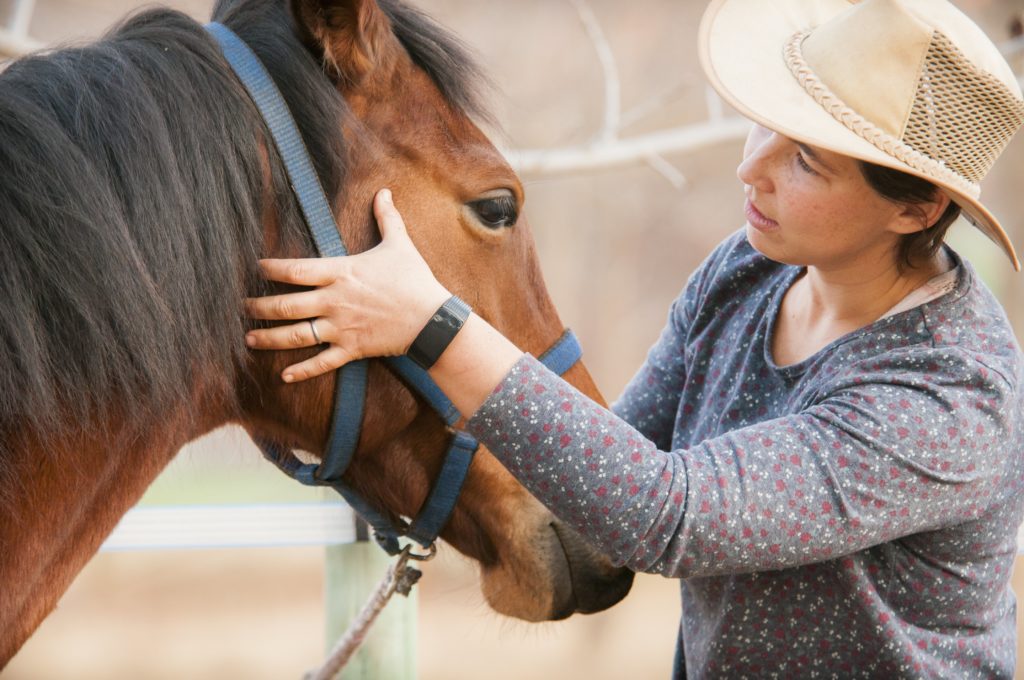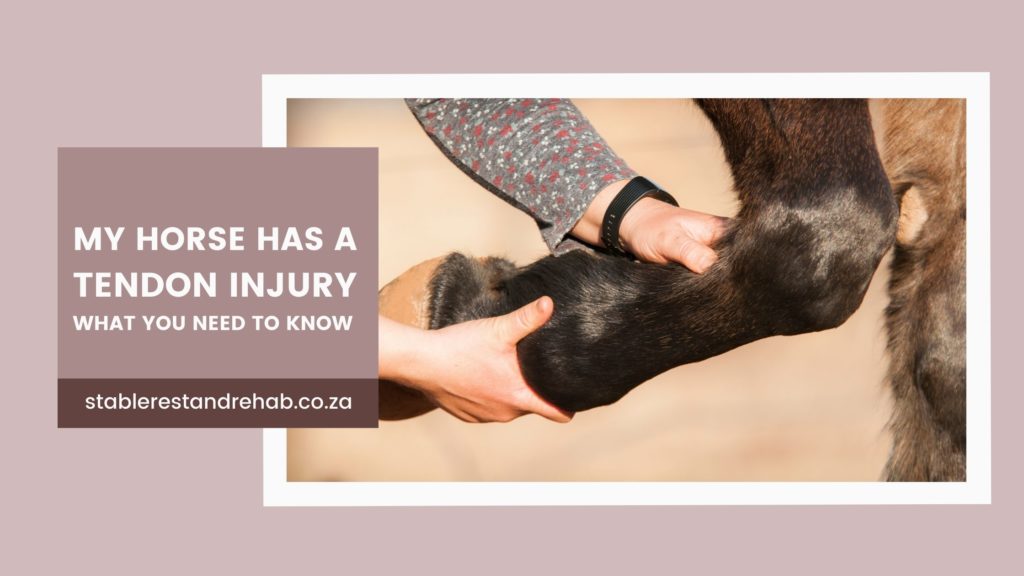If your vet has recently diagnosed your horse with a tendon injury, you may be sitting staring at the home exercise program they have given you, wondering how you are supposed to keep your horse on stable rest for the next 3-6 months, considering all the goals you won’t be able to pursue together for the next year, and trying to figure out how on earth you are going to manage the rehabilitation process.
Tendon injuries take 9 to 12 months, in some cases up to 18 months, to heal and don’t regain their former strength even after this period, predisposing them to future injury. They require extensive stable rest, an in-hand walking program progressing over months, regular veterinary check-ups, and occasionally additional veterinary intervention.
If you would like more information on how you can help your horses tendon to heal, keep reading.
How does a horse injure its tendon?
Tendon injuries can occur as a result of trauma, for example, a severe slip or fall can overstretch the tendon and cause it to tear. Alternatively, blunt trauma to the tendon can cut through the tendon, potentially as a result of getting caught in a fence, getting kicked, or colliding with a sharp object. There are many ways our horses can injure themselves!
The second way tendon injuries occur, is as a result of accumulated micro trauma over time, otherwise known as overuse injuries. For example, a horse with poor conformation or posture may already be placing his tendons under strain, and as a result of a working program, microtears are occurring in the tendon more regularly than they can heal, leading to degeneration in the structure and strength of the tendon until it finally tears. In these cases, injury to the tendon can often occur on both sides, with one side worse than the other.
How does the tendon heal?
Tendons heal incredibly slowly! The sooner an injury is identified and diagnosed, and the sooner we intervene to allow them to heal, the better the horses chance of recovery will be.
Tendon healing follows the same phases of healing as other soft tissue structures, but the timeline looks a little different. This is primarily due to the lack of blood supply directly within the tendon. The tendons in the horse’s leg are surrounded by a synovial sheath and receive their blood supply from the muscle-tendon junction, and the muscle-bone junction.
These are the phases of healing:
| Inflammation | Immediately after the injury, lasting for 72 hours |
| Reparative | By day 5, collagen will have created a random scaffold within the tendon tear. For the next four weeks, collagen production will continue to increase, and by day 60 will start to decrease. |
| Remodelling | From day 28 after injury, collagen fibres start to realign themselves according to the stress placed on the tendon, and by day 112 the tendon should be appearing normal. Horses may be able to return to normal work from 9 months, and in severe cases from 18 months. |
| Strength of healing tendon | We estimate that at 6 weeks, the tendon has regained about 60% of its strength, while at 12 months it will have regained 80% of strength. |
To help the tendon heal optimally, we need to provide just enough resistance to the tendon through exercise to slightly stretch the healing collagen fibres, stimulating them to align correctly, but little enough that we do not damage the tendon in the process. This can be a fine balance to aim to achieve, and exercise needs to be continuously re-assessed and progressed as the tendon slowly heals.
What treatments are available?
Controlled exercise and rest are the most important treatment interventions we need to focus on, but there are a few additional options we might try. It is important to note, that while there are MANY treatment options available, most have not been shown to be beneficial to the long term healing of tendon injuries, and so it is a good idea to focus on the ‘basics’ and do them as well as we can, instead of trying any and every novel treatment option available to us.
In the initial inflammatory phase, the application of cold can be hugely beneficial in reducing pain, swelling and inflammation. The use of a spa or immersion in ice water is more effective than using ice packs.
Compression or pressure during the initial phase is also very beneficial and can be achieved through cold water spa as well as through bandaging.
Rest is essential during the initial phases of injury, with the most important consideration being that the amount of stress on the tendon is reduced and limited. With a severe injury to the tendon, a splint or orthosis may be needed in this phase.
There are additional medical options that may improve the quality of healing and repair and may reduce the chances of re-injury. These include the injection of platelet-rich plasma and/or stem cells, hyaluronic acid, or corticosteroids into the tendon injury. Your vet will be able to advise you on the best option for your horse if you would like to pursue these options.
Extracorporeal shock wave therapy (ESWT) is another modality that your vet might recommend, and which can prove beneficial. It has especially been used for Proximal Suspensory Ligament Desmitis, a condition that can be very challenging to treat.
Pulsed electromagnetic field therapy (PEMF) can form a part of the daily treatment routine of tendon injuries, to help reduce pain and improve the quality of healing. Not all PEMF devices are created equal, and it is important to speak to your Veterinary Physiotherapist before purchasing a product.
Daily physiotherapy in the form of passive range of motion stretches and exercises can help reduce pain and improve healing.
Your Veterinarian will likely also prescribe some systemic pain medication for your horse. It is important to administer these medications as prescribed, as they can influence the healing process negatively if taken at the incorrect phase of healing.
At Stable Rest and Rehab, we use a combination of modalities during the rehabilitation of tendon injuries, including laser therapy, PEMF, cold water salinated spa treatments, compression bandaging, controlled exercise, and stable rest. We can also work with your Veterinarian or other service providers to include tendon injections or ESWT for your horse.
Controlled exercise
Controlled exercise is a component of tendon healing that cannot be underestimated, helping to resolve inflammation, maintain gliding of the tendon, promote collagen alignment and remodelling, and optimizing the strength of the tendon.
Progression in exercise is managed and monitored with regular ultrasound scans and evaluation of clinical signs in the patient.
To learn more about how we use controlled exercise at Stable Rest and Rehab to optimize the healing of your horse, read more here.
Stable rest
Stable rest can be an intrinsic part of protecting the tendon from re-injury, but it can also be frustrating for the horse, owner and yard management. Placing a horse on stable rest for an extended period means we need to consider multiple factors, such as adjustments to their diet, mental and emotional stimulation and support, safety for patients and handlers, and sufficient movement and exercise to prevent the negative effects of prolonged movement restriction.
To learn more about what your horse needs on full stable rest and how we manage these challenges at Stable Rest and Rehab, read more here.
Reducing the incidence of reinjury
When we spoke earlier about how horses injure their tendons, we mentioned two things. The first is trauma as a result of an accident. We all know that accidents happen, and sometimes they just can’t be prevented. We also know that some horses are far more prone to injury than others. When we improve our awareness of our bodies, as well as our control over all the parts of our bodies and how we can use them in space (our proprioception and motor control), we are far better able to navigate the obstacles life throws at us, and therefore become less likely to slip, fall, run into objects, etc.
Through our exercise program, we have a strong focus on developing these systems in our patients, which will help them as they return to their lives to not only navigate their environments with more finesse, grace and precision, but also their competitive careers.
The second way horses can injure their tendons, and a far more common scenario is as a result of microtrauma accumulated over time. This is often caused by poor posture or conformation, or as a result of compensation from another older injury that has caused them to change their movement patterns.
At Stable Rest and Rehab, we focus on treating the whole body – injuries rarely occur in isolation! Restoring good functional posture and movement patterns, and in so doing we try and target the cause of the initial injury so that it won’t occur again in future.
While we do have a strong focus on the above points, it is important to mention that a tendon that has been injured will always be weaker than it used to be, and for that reason alone there will always be a risk that it can become injured again, but we hope that by giving the horse and owner the knowledge and skills to use their bodies optimally and with consideration for the weaker structure/s, we can start to reduce the risk of reinjury.
Conclusion
There are many components to balance, learn about and consider when we are dealing with rehabilitating a tendon injury in our horses, and this process can feel overwhelming and hopeless at times. Tendon injuries don’t carry the best prognosis, and it is entirely possible that your horse won’t be able to return to their full lives again once the injury has healed.
If you would like to learn more about how we can help you at Stable Rest and Rehab, why not get in touch?

About the Author:
Ané Lloyd registered Veterinary Physiotherapist, owner and manager of Stable Rest and Rehab is dedicated to the individual care and rehabilitation of each horse boarding at our exclusive facility.
Have you helped your horse recover from a tendon injury?
You can help future horses and owners to navigate this challenging journey by filling in our quick survey:


Thanks for your blog, nice to read. Do not stop.
Thank you Mark